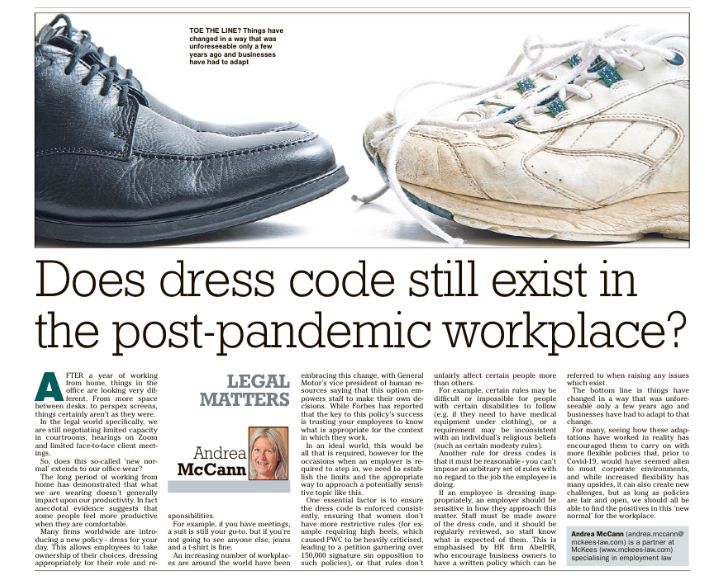After a year of working from home, things in the office are looking very different. From more space between desks, to perspex screens, things certainly aren’t as they were. Andrea McCann, Partner McKees writes in today’s Irish News Legal Matters column.
In the legal world specifically, we are still negotiating limited capacity in courtrooms, hearings on zoom and limited face to face client meetings.
So, does this so called ‘new normal’ extends to our office wear?
The long period of working from home has demonstrated that what we are wearing doesn’t generally impact upon our productivity. In fact anecdotal evidence suggests that some people feel more productive when they are comfortable.
Many firms worldwide are introducing a new policy – dress for your day. This allows employees to take ownership of their choices, dressing appropriately for their role and responsibilities.
For example, if you have meetings, a suit is still your go-to, but if you’re not going to see anyone else, jeans and a t-shirt is fine.
An increasing number of workplaces are around the world have been embracing this change with General Motor’s vice president of human resources saying that this option empowers staff to make their own decisions. While Forbes has reported that the key to this policy’s success is trusting your employees to know what is appropriate for the context in which they work.
In an ideal world, this would be all that is required, however for the occasions when an employer is required to step in, we need to establish the limits and the appropriate way to approach a potentially sensitive topic like this.
One essential factor is to ensure the dress code is enforced consistently, ensuring that women don’t have more restrictive rules (for example requiring high heels, which caused PWC to be heavily criticised, leading to a petition garnering over 150,000 signature sin opposition to such policies), or that rules don’t unfairly affect certain people more than others.
For example, certain rules may be difficult or impossible for people with certain disabilities to follow (e.g. if they need to have medical equipment under clothing), or a requirement may be inconsistent with an individual’s religious beliefs (such as certain modesty rules).
Another rule for dress codes is that it must be reasonable – you can’t impose an arbitrary set of rules with no regard to the job the employee is doing.
If an employee is dressing inappropriately, an employer should be sensitive in how they approach this matter. Staff must be made aware of the dress code, and it should be regularly reviewed, so staff know what is expected of them. This is emphasised by HR firm AbelHR, who encourage business owners to have a written policy which can be referred to when raising any issues which exist.
The bottom line is things have changed in a way that was unforeseeable only a few years ago and businesses have had to adapt to that change.
For many, seeing how these adaptations have worked in reality has encouraged them to carry on with more flexible policies that, prior to Covid-19, would have seemed alien to most corporate environments, and while increased flexibility has many upsides, it can also create new challenges, but as long as policies are fair and open, we should all be able to find the positives in this ‘new normal’ for the workplace.

